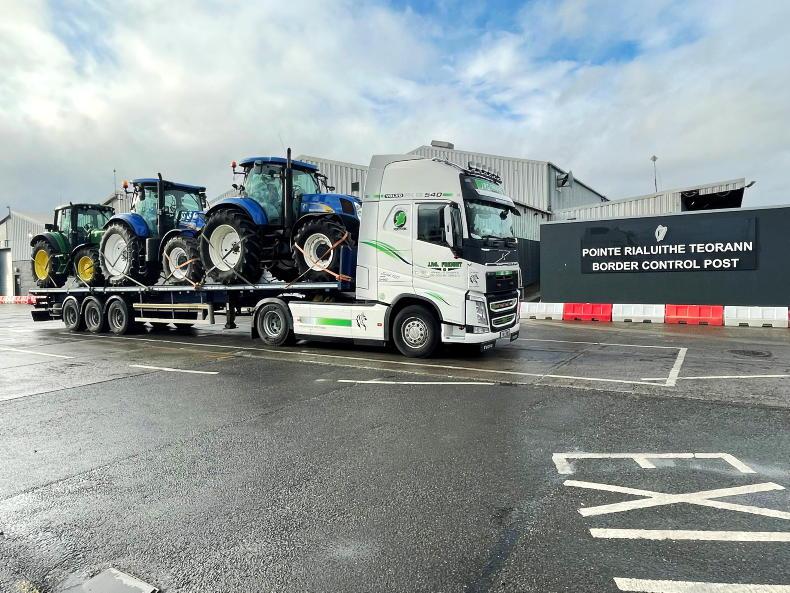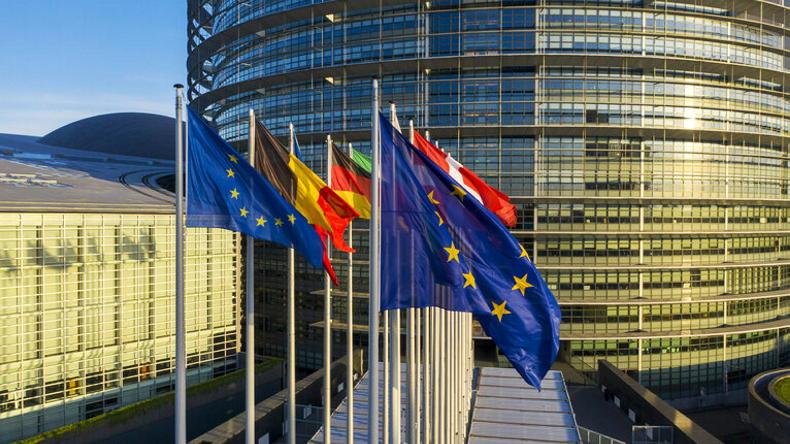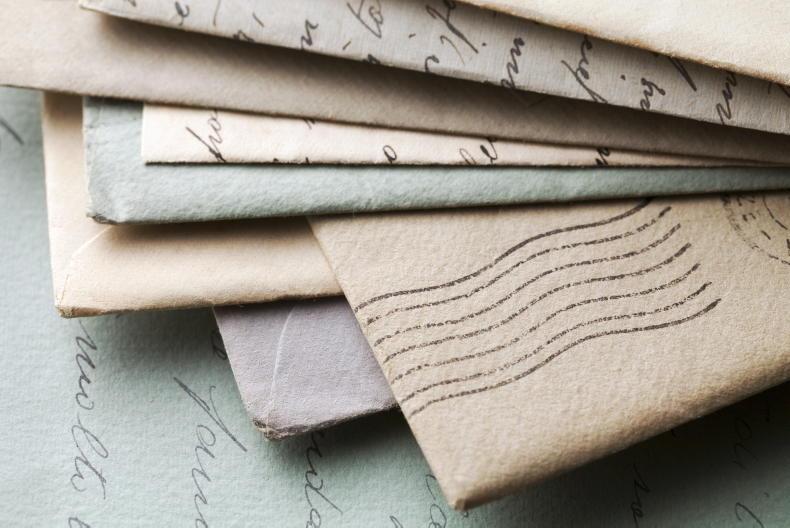For decades, Britain has been by far the largest source of used equipment for Irish farmers, contractors and machinery dealers looking to import machinery. FTMTA figures show that a total of 3,010 used tractors were imported during 2020, which was only marginally behind the 3,045 used tractors imported in 2019.
It is estimated 95% of these used tractors came from Britain. To put this into context, the last two-year average shows there were 1,939 new tractors sold in Ireland each year.
Historically, once you sorted out the haulage, tractors and machinery were able to move freely across the Irish Sea. However, this is not now the case and the process has become a lot more complex. If you are intending to import or export a machine to or from Britain, there are two bodies you need to work through, the Department of Agriculture, Food and the Marine (DAFM) and the Customs Division of the Revenue.
Brexit
When Brexit came into effect on 1 January this year, Britain became a third country. A third country is referred to by the EU as a country that is not a member of the European Union. EU legislation means that there are specific requirements for the trade (import and export) of second hand/used machinery between the EU and third countries (non-EU).
These requirements apply to all secondhand machinery which has been used for agricultural, forestry, horticultural or soil preparation/cultivation purposes. This includes tractors and all harvesting and threshing machinery.

What’s involved in importing/exporting of machinery from/to Britain?
All importers and exporters of secondhand/used machinery are now required to be registered with the DAFM. Importers are also required to register with TRACES NT (European Import Notification System). Registration is free of charge.
All used machinery destined for import/export is required to be clean and free of soil or plant debris. A phytosanitary certificate will be required and will be provided by the National Plant Protection Organisation (NPPO) of the exporting country. When importing, all relevant documents will have to be submitted to DAFM at least 24 hours before arrival of the machine/consignment.
When exporting, an application will have to be submitted to the DAFM’s Export Certification System (ECS) for the necessary certificates, at least 14 days prior to departure. The required certificates will have to be sent to the British (GB) customer prior to departure. The GB customer will then be required to submit documents to GB authorities at least four hours prior to arrival if travelling by air and at least one working day if travelling by road/sea.
Some other countries will also require phytosanitary certification.
The inspection
The used machines in question will be subject to physical checks upon arrival at the dedicated DAFM inspection points at the port. If the machine is in a container, it will be removed for the inspection. If it is on a low-loader, it may not have to be removed.
Inspectors will be checking for cleanliness, ensuring it is free of soil or any plant debris. All aspects of the machine will be inspected, including the inside of the cab (if it is fitted with one). This is a visual inspection but if something exotic is found it will be brought to a DAFM laboratory for further inspection.
If the machine passes the physical inspection, it is released. However, DAFM says that any machine which fails this inspection will be issued with a non-compliance notice and will be rejected.
This means it can’t be released into circulation in Ireland, meaning it is sent back to where it came from, whether that be Britain or further afield.
It is worth noting that these regulations apply to the island of Ireland (NI and ROI) for the importing and exporting of used machinery to and from Britain.
Customs
If you move or are intending to move goods to, from or through Britain, you will need to register with Customs. To do the customs work, you will need the necessary software system. Many businesses involved in the movement of goods between Ireland and GB use customs agents who handle all the necessary paperwork. If you are considering a once off or infrequent trading with GB, this is certainly the most straightforward option.
Otherwise, you will need to register with the Customs by getting an Economic Operators Registration and Identification (EORI) number. This number is used as a common reference number for interactions with the customs authorities in all member states across the EU.
Declarations
Each time you export goods to or import goods from Britain, you will have to complete customs declarations. You, or an agent acting on your behalf, must have the facility to lodge electronic customs declarations to Revenue. If you are importing a machine from Britain, an export declaration will be required before it leaves Britain. You should clarify whether you or the seller is looking after this before a deal is agreed. If these aren’t completed, the ferry company will not allow you to board. In addition, import declarations also need to be filled out for Irish customs clearance at the point of entry.
Different types of machines will have different CN codes. A CN code is a customs/tariff designation required for export certificates. Each code will carry an import duty rate you may be liable to pay. For example, wheeled agricultural and forestry tractors carry a rate of 0%.
What’s required for a customs declaration?
1 Commodity code
Different types of machines will have different commodity codes. This code is used to determine the import duties (if any) you will be liable to pay. It is important you have your products correctly classified or it may result in delays.
2 Customs value of your goods
The customs value of your goods must be entered on your customs declaration. It is made up of the invoice price plus the cost of transport and insurance.
3 Origin of your goods
You need to know where the product you are importing originates from. The country of origin of the goods is used to determine the amount of duty payable. This information should be provided by your supplier.
Depending on the type of product, you may need to provide supplementary documentation to support your declaration which may include the following:
Commercial invoice.Bill of lading or airway bill.Packing list.Veterinary or plant health certificates.Licences.VAT
Alongside the potential customs duties, there will be a VAT charge. If you are registered for VAT in Ireland, you can avail of postponed accounting which means you don’t pay any VAT at the point of importation, but you can file it in your VAT returns. However, if you import a machine and you are not VAT-registered, you will be liable to pay 23% VAT at the point of entry before the machine is released. Also, bear in mind that there should not be any GB VAT charged on the sale of the machine in GB as the goods are being exported, meaning the supplier in GB can zero rate it for VAT.
Comment
Britain has been by far the largest source of used equipment for those looking to import machinery, and this isn’t going to change any time soon. The new regulations post-Brexit have made this process more difficult, more costly and more time-consuming. But it is not impossible and Britain will most likely continue to remain the most appealing used equipment market in the long term.
Many machinery dealers in Britain would have sold kit outside of the EU previous to Brexit so the same phytosanitary report and paperwork was required. Likewise, some of these dealers are now factoring in the full clean-down process in order to secure the phytosanitary report in the price of the used tractor/implement. If not, the purchaser should push for such an agreement.
It is important that anyone considering importing used kit from Britain doesn’t make any assumptions. You will have to have all the Is dotted and the Ts crossed or machines will face delays pre-boarding and in the port on arrival. If using a customs agent, it is advised to make early contact as such services are inundated at present.
Machinery dealer comment: Paddy Lacey Tractors, Wexford
“Brexit has brought about a huge inconvenience to importing used tractors from England. There is a cost involved, but it’s not huge. The big issue is the delays and loss of time alongside all the paperwork. We are using a customs agent but we are still finding it difficult to find out key information. A lot of dealers like ourselves are struggling to get our heads around it. There is also a lot of hassle from the haulier’s perspective and they don’t want to collect single tractors. The transport costs have also increased. Britain is a tough market at the minute. The price of the pound is wrong, clean used tractors are expensive and scarce and there is sizeable inconvenience involved. The bottom line is that it’s not impossible to get used equipment in, but it takes a lot more time, it is costing more and there is a lot more paperwork involved.”
Requirements for the import of secondhand machinery
Register with DAFM.Register with TRACES NT (European Import Notification System).A phytosanitary certificate is required and will be provided by the National Plant Protection Organisation (NPPO) of the exporting country.Submit all documents to DAFM at least 24 hours before arrival of consignment through DAFM’s Import Control web portal.Secondhand machinery will be subject to physical checks upon arrival.Requirements for the export of second hand machinery
Register with DAFM.A phytosanitary certificate is required for the export of second hand machinery to GB.Use DAFM’s Export Certification System (ECS) to submit application for necessary certificates. This needs to be submitted at least 14 days prior to departure.Notify and send the required certificates to the GB customer/agent prior to departure.GB customer/agent is required to submit documents to GB authorities at least four hours prior to arrival if travelling by air and at least one working day if travelling by road/sea.
For decades, Britain has been by far the largest source of used equipment for Irish farmers, contractors and machinery dealers looking to import machinery. FTMTA figures show that a total of 3,010 used tractors were imported during 2020, which was only marginally behind the 3,045 used tractors imported in 2019.
It is estimated 95% of these used tractors came from Britain. To put this into context, the last two-year average shows there were 1,939 new tractors sold in Ireland each year.
Historically, once you sorted out the haulage, tractors and machinery were able to move freely across the Irish Sea. However, this is not now the case and the process has become a lot more complex. If you are intending to import or export a machine to or from Britain, there are two bodies you need to work through, the Department of Agriculture, Food and the Marine (DAFM) and the Customs Division of the Revenue.
Brexit
When Brexit came into effect on 1 January this year, Britain became a third country. A third country is referred to by the EU as a country that is not a member of the European Union. EU legislation means that there are specific requirements for the trade (import and export) of second hand/used machinery between the EU and third countries (non-EU).
These requirements apply to all secondhand machinery which has been used for agricultural, forestry, horticultural or soil preparation/cultivation purposes. This includes tractors and all harvesting and threshing machinery.

What’s involved in importing/exporting of machinery from/to Britain?
All importers and exporters of secondhand/used machinery are now required to be registered with the DAFM. Importers are also required to register with TRACES NT (European Import Notification System). Registration is free of charge.
All used machinery destined for import/export is required to be clean and free of soil or plant debris. A phytosanitary certificate will be required and will be provided by the National Plant Protection Organisation (NPPO) of the exporting country. When importing, all relevant documents will have to be submitted to DAFM at least 24 hours before arrival of the machine/consignment.
When exporting, an application will have to be submitted to the DAFM’s Export Certification System (ECS) for the necessary certificates, at least 14 days prior to departure. The required certificates will have to be sent to the British (GB) customer prior to departure. The GB customer will then be required to submit documents to GB authorities at least four hours prior to arrival if travelling by air and at least one working day if travelling by road/sea.
Some other countries will also require phytosanitary certification.
The inspection
The used machines in question will be subject to physical checks upon arrival at the dedicated DAFM inspection points at the port. If the machine is in a container, it will be removed for the inspection. If it is on a low-loader, it may not have to be removed.
Inspectors will be checking for cleanliness, ensuring it is free of soil or any plant debris. All aspects of the machine will be inspected, including the inside of the cab (if it is fitted with one). This is a visual inspection but if something exotic is found it will be brought to a DAFM laboratory for further inspection.
If the machine passes the physical inspection, it is released. However, DAFM says that any machine which fails this inspection will be issued with a non-compliance notice and will be rejected.
This means it can’t be released into circulation in Ireland, meaning it is sent back to where it came from, whether that be Britain or further afield.
It is worth noting that these regulations apply to the island of Ireland (NI and ROI) for the importing and exporting of used machinery to and from Britain.
Customs
If you move or are intending to move goods to, from or through Britain, you will need to register with Customs. To do the customs work, you will need the necessary software system. Many businesses involved in the movement of goods between Ireland and GB use customs agents who handle all the necessary paperwork. If you are considering a once off or infrequent trading with GB, this is certainly the most straightforward option.
Otherwise, you will need to register with the Customs by getting an Economic Operators Registration and Identification (EORI) number. This number is used as a common reference number for interactions with the customs authorities in all member states across the EU.
Declarations
Each time you export goods to or import goods from Britain, you will have to complete customs declarations. You, or an agent acting on your behalf, must have the facility to lodge electronic customs declarations to Revenue. If you are importing a machine from Britain, an export declaration will be required before it leaves Britain. You should clarify whether you or the seller is looking after this before a deal is agreed. If these aren’t completed, the ferry company will not allow you to board. In addition, import declarations also need to be filled out for Irish customs clearance at the point of entry.
Different types of machines will have different CN codes. A CN code is a customs/tariff designation required for export certificates. Each code will carry an import duty rate you may be liable to pay. For example, wheeled agricultural and forestry tractors carry a rate of 0%.
What’s required for a customs declaration?
1 Commodity code
Different types of machines will have different commodity codes. This code is used to determine the import duties (if any) you will be liable to pay. It is important you have your products correctly classified or it may result in delays.
2 Customs value of your goods
The customs value of your goods must be entered on your customs declaration. It is made up of the invoice price plus the cost of transport and insurance.
3 Origin of your goods
You need to know where the product you are importing originates from. The country of origin of the goods is used to determine the amount of duty payable. This information should be provided by your supplier.
Depending on the type of product, you may need to provide supplementary documentation to support your declaration which may include the following:
Commercial invoice.Bill of lading or airway bill.Packing list.Veterinary or plant health certificates.Licences.VAT
Alongside the potential customs duties, there will be a VAT charge. If you are registered for VAT in Ireland, you can avail of postponed accounting which means you don’t pay any VAT at the point of importation, but you can file it in your VAT returns. However, if you import a machine and you are not VAT-registered, you will be liable to pay 23% VAT at the point of entry before the machine is released. Also, bear in mind that there should not be any GB VAT charged on the sale of the machine in GB as the goods are being exported, meaning the supplier in GB can zero rate it for VAT.
Comment
Britain has been by far the largest source of used equipment for those looking to import machinery, and this isn’t going to change any time soon. The new regulations post-Brexit have made this process more difficult, more costly and more time-consuming. But it is not impossible and Britain will most likely continue to remain the most appealing used equipment market in the long term.
Many machinery dealers in Britain would have sold kit outside of the EU previous to Brexit so the same phytosanitary report and paperwork was required. Likewise, some of these dealers are now factoring in the full clean-down process in order to secure the phytosanitary report in the price of the used tractor/implement. If not, the purchaser should push for such an agreement.
It is important that anyone considering importing used kit from Britain doesn’t make any assumptions. You will have to have all the Is dotted and the Ts crossed or machines will face delays pre-boarding and in the port on arrival. If using a customs agent, it is advised to make early contact as such services are inundated at present.
Machinery dealer comment: Paddy Lacey Tractors, Wexford
“Brexit has brought about a huge inconvenience to importing used tractors from England. There is a cost involved, but it’s not huge. The big issue is the delays and loss of time alongside all the paperwork. We are using a customs agent but we are still finding it difficult to find out key information. A lot of dealers like ourselves are struggling to get our heads around it. There is also a lot of hassle from the haulier’s perspective and they don’t want to collect single tractors. The transport costs have also increased. Britain is a tough market at the minute. The price of the pound is wrong, clean used tractors are expensive and scarce and there is sizeable inconvenience involved. The bottom line is that it’s not impossible to get used equipment in, but it takes a lot more time, it is costing more and there is a lot more paperwork involved.”
Requirements for the import of secondhand machinery
Register with DAFM.Register with TRACES NT (European Import Notification System).A phytosanitary certificate is required and will be provided by the National Plant Protection Organisation (NPPO) of the exporting country.Submit all documents to DAFM at least 24 hours before arrival of consignment through DAFM’s Import Control web portal.Secondhand machinery will be subject to physical checks upon arrival.Requirements for the export of second hand machinery
Register with DAFM.A phytosanitary certificate is required for the export of second hand machinery to GB.Use DAFM’s Export Certification System (ECS) to submit application for necessary certificates. This needs to be submitted at least 14 days prior to departure.Notify and send the required certificates to the GB customer/agent prior to departure.GB customer/agent is required to submit documents to GB authorities at least four hours prior to arrival if travelling by air and at least one working day if travelling by road/sea. 










SHARING OPTIONS